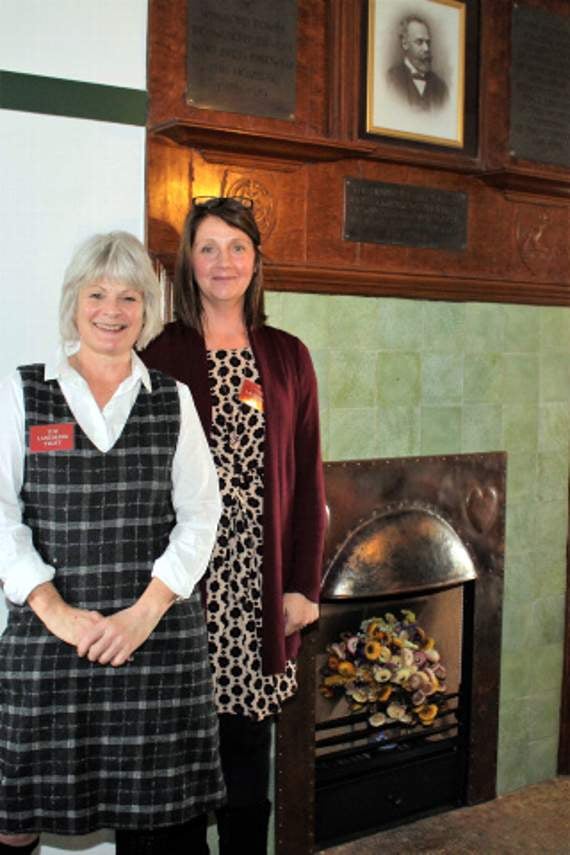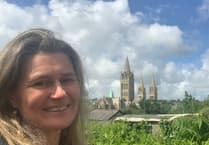RESTORATION work on the Landmark Trust’s latest property has been completed and the Winsford Cottage Hospital, in Halwill Junction, opened its doors on Sunday, October 20, to welcome visitors to view the unique building.
During the open weekend, the Landmark Trust celebrated the completion of its restoration with many of the supporters of the project and volunteers who helped across the year onsite undertaking the works.
A spokesperson said: “We were thrilled to have around 400 visitors across the two days. WWI re-enactors helped bring the wards to life and demonstrate early 20th-century medical care. You also asked about a magnificent printing press — there is a small building near the hospital, the generator space, now rented by a tenant who uses it as a printing space and who also generously opened the doors across the weekend.”
They added: “In the east wing is a permanent interpretation space, which will be open on Monday and Friday afternoons by appointment and at our regular open weekends going forward — in 2020 we’ll have open weekends in July, September and November.”
Built in 1899 by Maria ‘Molly’ Medley in memory of her husband George to serve the local community, Winsford was designed by pioneering arts and crafts architect and designer Charles Fredrick Annesley Voysey.
In the century before the National Health Service, the advent of the ‘cottage hospital’ revolutionised the lives of ordinary people. Winsford opened in 1900 with seven beds across three wards, treating men, women and children, to serve 13 parishes.
C F A Voysey, one of the most sought-after architects of the 20th century and a family friend of the Medleys, firmly believed in the healing power of nature. Winsford was Voysey’s only hospital and one of only two built public buildings, and is entirely representative of his distinctive style — rooted in natural forms, executed in fine local materials with exceptional craftsmanship.
The building was used as a hospital from 1900 until 1998 whereupon it was saved for the community by the Winsford Trust.
The cottage hospital is now in the care of the Landmark Trust. It becomes the 202nd historically significant building to be saved and sensitively transformed for self-catering holidays by the charity, while part of the site has been reopened for mixed community use.
The ambitious project was only possible with £487,000 granted by The National Lottery Heritage Fund thanks to National Lottery players, on top of an earlier £96,000 development grant, £23,000 from the Andrew Lloyd Webber Foundation plus generous support from several trusts, gifts in wills, and more than 1,373 individuals who supported the Landmark Trust’s public appeal.
When it first came to Landmark’s attention, the precious building was in a state of advanced decay.
Landmark’s project to save Winsford culminated in over a year of intense work on site, supported by a wide team of experts and local craftspeople.
A complete overhaul conserved everything possible, gently returning the site to its 1914 state — when a small, considered extension was added — with minimal adaption or intervention.
The sweeping Cornish Delabole slate roof was taken up, repaired and returned, two missing windows from the long ribbon of simple stone mullioned windows were reinstated and internal lime plaster has been extensively replaced. Original fireplaces featuring Voysey’s signature elongated hearts and air vent covers with whimsical birds and trees were carefully conserved.
Lost fixtures and fittings were reinstated and expert paint analysis informed an exact redecoration scheme of a striking white and dark green.
Winsford’s furnishings are in keeping with Voysey’s distinct aesthetic — early 20th century furniture sits alongside hand-crafted pieces produced in the charity’s Cotswolds workshop.
A portrait of Dr Thomas Linnington Ash, medical officer and first surgeon in charge at Winsford, hangs alongside other sympathetic artwork. Following newly discovered archive evidence, three charming Voysey fabric designs have been specially reproduced for the curtains from an original pattern book specifically for Winsford, while — in a classic Voysey touch — each curtain has been lined with red fabric.
The work has been a catalyst for craft training, volunteer activities and renewed community involvement. An extensive programme has seen Prince’s Foundation apprentices craft Voysey-style gates and college students train in stonemasonry, while volunteers learnt the arts of blacksmithing and green-timber furniture making. In a herculean task guided by expert conservators, a team of volunteers spent hours carefully removing glue and chipping off concrete screed to reveal and restore one of the highlights of Voysey’s design — a golden mosaic floor running the length of the hospital.
Dr Anna Keay, Landmark Trust’s director, said: “Winsford quite simply changed people’s lives. It is a rare example of a building which matters both for its architectural merits and for the life-changing impact it had on the communities it served.
“We were determined to offer a lifeline to this irreplaceable structure and that we’ve been successful is thanks not only to our supporters, but to a host of talented craftsmen and women, volunteers and members of the local community. It is fitting that a building which offered respite to so many, now has been given the care it long needed. We are delighted its future is secure.”
In keeping with its original social purpose, ongoing community access lays at the heart of the Landmark Trust’s project to save Winford.
The east end has been set aside for ongoing community use, with a meeting and treatment room for ancillary health practitioners to hire, while each year free stays will be offered to charities through Landmark’s ‘50 for Free’ scheme.





Comments
This article has no comments yet. Be the first to leave a comment.